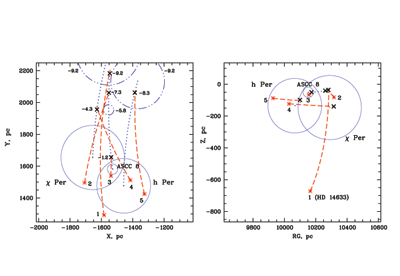Highlights - Volume 489-1 (October I 2008)
- Details
- Published on 16 September 2008
| HIGHLIGHTS: this week in A&A |
Volume 489-1 (October I 2008)
| In section 5. Galactic structure, stellar clusters and populations “On the origin of field O-type stars”, by E. Schilbach and S. Röser, A&A 489, p. 105 Using new compilations of proper motions and radial velocities, the probable birthplaces of a large sample of Galactic field O stars are traced using linearized (epicyclic) dynamics. The sample of 93 O stars and 131 clusters and associated, with full kinematics and distances, yields membership identifications for 73 stars over a timespan of 10 MYr. Of these, a small but important subset (14) are so young that the O stars may have been lost during the proto-cluster formation stage. The authors also discuss, at some length, the cases of individual stars and clusters, especially those far from the Galactic plane. |
|
| In section 4. Extragalactic astronomy “Physical and kinematical properties of the X-ray absorber in the broad absorption line quasar APM 08279+5255”, by J.M. Ramirez, A&A 489, p. 57 The broad absorption line (BAL) quasar APM08279+5255 is one of the brightest objects at high redshift (z=3.9), amplified by a factor 50-100 by a gravitational lens. Previous observations in X-ray with XMM-Newton and Chandra, obtained successively with a 2 week interval in the frame of the quasar, have detected absorption lines of iron in a highly ionized state, which were interpreted by two models: either a single line where the non-Gaussian Fe line corresponds to an absorption edge, or the feature is decomposed in two lines, corresponding to a gas ejected at relativistic velocity, 0.2c-0.4c. For the first time, the author has carried out a self-consistent photoionization modeling of the X-ray spectrum, considering a two-absorber model, which can account for both observations in a more coherent manner. The two absorbing components have different velocity and ionizing states, but the same over-abundance of iron, implying that their processing in a strong starburst environment. |
| In section 10. Planets and planetary systems “Is electric charge separation the main process for kinetic energy transformation into meteor phenomenon?”, by P. Spurny and Z. Ceplecha, A&A 489, p. 449 In the title the authors pose an interesting question. They present measurements of fireball light curves, using fast photometer observations that would seem to answer this question in the affirmative. Could this idea be the starting point for a new research field in meteor science, namely the study of the effects of triboelectricity? |
© Astronomy & Astrophysics 2008


